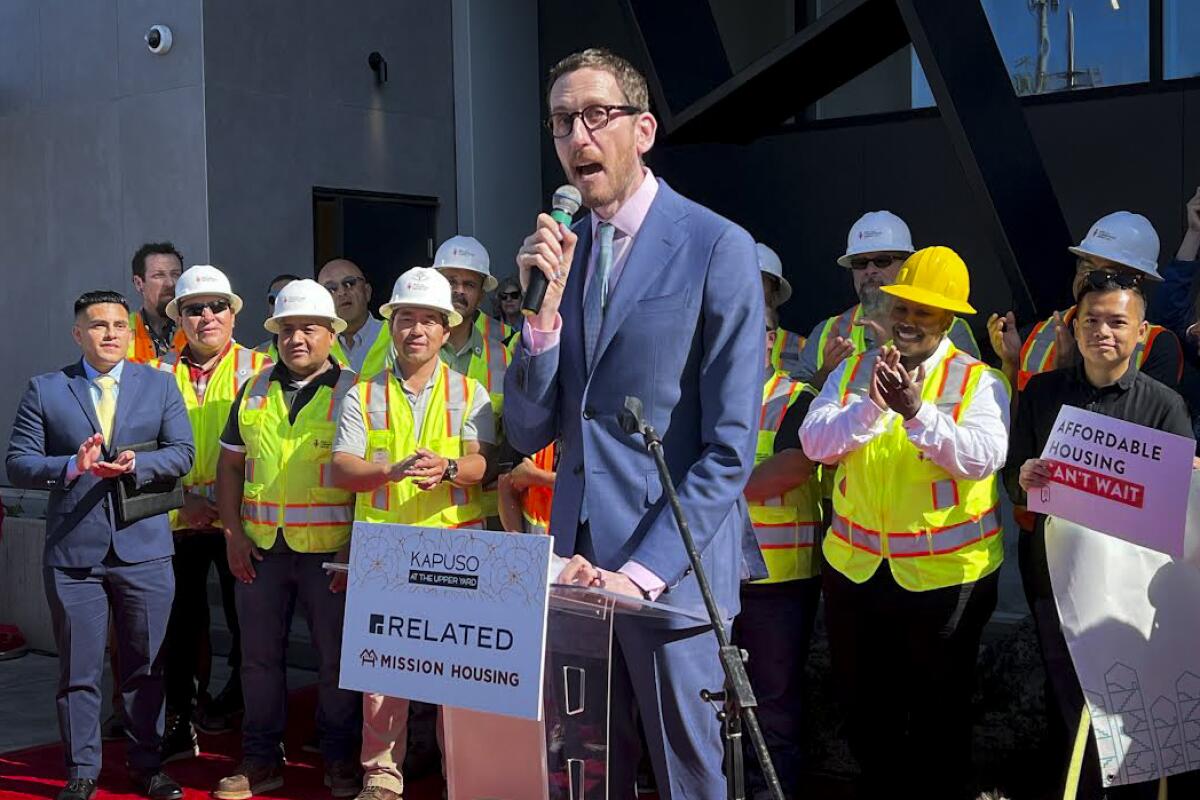How the carpenters’ union broke the California logjam over new housing laws

- Share via
Every few months over the last two years, a sea of California carpenters has clogged the state Capitol to voice their support of high-profile housing legislation, their yellow and orange vests, hard hats and work boots in stark contrast to the suits, dresses and fancy shoes more customary in the hallways and hearing rooms of Sacramento.
Their grassroots lobbying has paid off with major legislative wins, including a pair of housing construction bills that Gov. Gavin Newsom signed into law Wednesday.
The laws represent more than the possibility of desperately needed new homes in a state with a 2.5-million-unit housing shortage. They also signal a shift in power dynamics among unions in California, and which ones have the greatest influence over labor standards at residential construction sites.
“The carpenters’ engagement on housing policy has been an absolute game changer,” said state Sen. Scott Wiener, a San Francisco Democrat who chairs his chamber’s housing committee and is the author of both laws, Senate Bills 4 and 423.
The first bill, SB 4, will make it easier for nonprofit colleges and faith organizations to build affordable homes on their land, while SB 423 will expand current law that lets developers expedite construction of multifamily projects in cities that have fallen behind on their state-mandated housing goals. The measures build on Assembly Bill 2011, a law that went into effect in July to convert buildings traditionally zoned for commercial retail and office space into affordable housing.
The new laws come after years of gridlock on housing proposals, leading to a rift between the California Conference of Carpenters, which is gaining newfound clout in the state Capitol, and the State Building and Construction Trades Council, one of the most influential players in Sacramento over the last decade.
Divisions bubbled up last year when the carpenters broke with the council and other influential unions and sponsored AB 2011, legislation the broader labor movement opposed because it lacked more rigorous job standards.
AB 2011 still mandates developers pay union-approved, or “prevailing,” wages and provide some healthcare benefits to workers, whether they’re union members or not. But it lacks the work standard the building trades union prefers, known as “skilled and trained,” a mandate that generally means laborers on job sites are unionized.
In the Democratic-controlled Legislature, where labor has an outsize influence, last year’s union infighting put many lawmakers in the uncomfortable position of having to choose a side.
Opponents of the skilled and trained standard argue it’s unachievable for housing developers because there aren’t enough union workers to meet the threshold. The trades union contends it’s a model that protects workers against exploitation and inadequate job safety protections.
“I think that prevailing wage in legislation for housing is a positive step,” said Chris Hannan, who was selected president of the State Building and Construction Trades Council this summer. “We don’t believe that that’s enough.”
Hannan succeeded Andrew Meredith, who resigned as president this year as the fight over labor standards raged in the Capitol.
Leadership at the carpenters union say they had no choice but to move forward with their own plan after discussions with the council fell apart.
Jay Bradshaw, executive secretary-treasurer of the Northern California Carpenters Union, said the new standards will help dismantle the underground construction economy and create job opportunities for union members, while safeguarding all workers against wage theft and other unfair labor practices currently happening on residential job sites.
The carpenters’ approach with the new standards is to organize members on job sites, but the trades council historically preferred requiring a unionized workforce to begin with.
“The labor standards we developed will significantly help our current membership. ... And it will also pull wages out of competition for those that are not represented,” Bradshaw said. “And then it’s our job to go organize those folks, not the government’s.”
Todd David, a political advisor to Wiener who served as executive director of the Housing Action Coalition in 2022, said the increased influence of the carpenters helped clear a path for new housing legislation.
“There were lots of quiet conversations between legislators with people who knew the carpenters very well, like, can they really do this?” David said.
They did.
So began a new era for the carpenters — and their Democratic allies eager to pass more sweeping housing bills into law using the same labor language.
“They showed up, and they really planted a flag in AB 2011,” said Assemblymember Buffy Wicks, the Oakland Democrat who wrote the legislation and chairs the Assembly committee on housing. “It was a breakout moment, I think, for the carpenters, where they decided enough is enough, we’re going to build housing, we’re going to do strong labor standards, we’re going to break the juggernaut that has been preventing us from actually accomplishing stuff in California in housing policy, with regards to labor standards. And they did it.”
The building trades council and its allies see the fight as far from over.
Hannan and others still consider the dispute over the labor language an easy choice between protecting workers or leaving them vulnerable to exploitation and job safety issues that may result from a lack of training.
“Our members ... are the very best at what they do. And they deserve us to fight as hard as we can for them,” Hannan said. “And we believe we are going to be the strongest, loudest voice for the construction worker.”
But the council lost its second battle this year after Wiener introduced his two bills, which largely include the same labor standards as last year’s deal.
Considered this year’s most consequential housing measure, SB 423 will extend by another decade current policy that lets developers streamline multifamily development in cities that have failed to plan for enough housing, which was set to expire in 2026. The original law passed in 2017 and has led to more than 18,000 proposed units, the majority for low-income families.
Last year’s coalition included the California Housing Consortium and other affordable housing groups and two other major unions — the California School Employees Assn. and the Service Employees International Union. This year, Wiener and the carpenters expanded support for the labor changes to add more construction unions.
“We just hung tough, and I think the nature of the crisis sort of forced people to do what they were not comfortable doing in terms of the labor issues,” said Danny Curtin, director of the carpenters conference. “Breaking ranks, or however you want to put it, is never simple or easy. And you don’t want to do it unless you really think there’s no real alternative. But it was unassailable, our bill was unassailable.”
Others don’t see it that way.
Scott Wetch, a lobbyist who represented several unions in the negotiations, described SB 423 as an undemocratic law that would come back to haunt every legislator who voted for it, a “political aneurysm” that “one day will burst.”
He criticized how housing might get built in a streamlined capacity that edges out community input, and questioned whether the healthcare requirements will withstand future legal challenges.
And while some unions were going to bat for their members fighting for more rigorous job rules, Wetch said, others, like the carpenters, “sold their members down the river.”
“The carpenters went to a handful of developers, and said to them, ‘Hey, we want to get some work, we want to work with you, and we will be the Judases that remove these worker protections that you don’t like, because we want to get some work out of you,’” Wetch said.
The carpenters have shrugged off those criticisms. They see the issue as a done deal, the new labor standards now the blueprint for housing legislation in California.
“The carpenters would rather be problem solvers than just problem fighters,” Bradshaw said.
More to Read
Sign up for Essential California
The most important California stories and recommendations in your inbox every morning.
You may occasionally receive promotional content from the Los Angeles Times.











